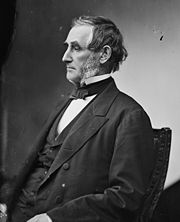.gif)
John Robbins (congressman)
Encyclopedia

Democratic Party (United States)
The Democratic Party is one of two major contemporary political parties in the United States, along with the Republican Party. The party's socially liberal and progressive platform is largely considered center-left in the U.S. political spectrum. The party has the lengthiest record of continuous...
member of the U.S. House of Representatives from Pennsylvania
Pennsylvania
The Commonwealth of Pennsylvania is a U.S. state that is located in the Northeastern and Mid-Atlantic regions of the United States. The state borders Delaware and Maryland to the south, West Virginia to the southwest, Ohio to the west, New York and Ontario, Canada, to the north, and New Jersey to...
.
John Robbins was born in Bustleton, Pennsylvania, (now a part of Philadelphia), near Lower Dublin Township, Pennsylvania
Lower Dublin Township, Pennsylvania
Lower Dublin Township, also known as Dublin Township, is a defunct township that was located in Philadelphia County, Pennsylvania. The township ceased to exist and was incorporated into the City of Philadelphia following the passage of the Act of Consolidation, 1854.-History:Commonly called Lower...
. He was a student at the Gunmere Academy in Burlington, New Jersey
Burlington, New Jersey
Burlington is a city in Burlington County, New Jersey, United States and a suburb of Philadelphia. As of the 2010 United States Census, the city population was 9,920....
. He moved to Philadelphia in 1836 and engaged in the manufacture of steel
Steel
Steel is an alloy that consists mostly of iron and has a carbon content between 0.2% and 2.1% by weight, depending on the grade. Carbon is the most common alloying material for iron, but various other alloying elements are used, such as manganese, chromium, vanadium, and tungsten...
. He was a member of the board of commissioners of the district of Kensington, Pennsylvania, and served as president several years.
Robbins was elected as a Democrat to the Thirty-first
31st United States Congress
The Thirty-first United States Congress was a meeting of the legislative branch of the United States federal government, consisting of the United States Senate and the United States House of Representatives. It met in Washington, D.C. from March 4, 1849 to March 3, 1851, during the last 17 months...
, Thirty-second
32nd United States Congress
The Thirty-second United States Congress was a meeting of the legislative branch of the United States federal government, consisting of the United States Senate and the United States House of Representatives. It met in Washington, D.C. from March 4, 1851 to March 3, 1853, during the third and...
, and Thirty-third
33rd United States Congress
The Thirty-third United States Congress was a meeting of the legislative branch of the United States federal government, consisting of the United States Senate and the United States House of Representatives. It met in Washington, D.C. from March 4, 1853 to March 3, 1855, during the first two years...
Congresses. He declined to be a candidate for renomination in 1854
United States House election, 1854
The U.S. House election, 1854 was an election for the United States House of Representatives in 1854.The 1854 election was the beginning of the end for both the Democratic and Whig Parties. Party lines were very blurred and a minority government was formed...
, and was an unsuccessful candidate for the office of the Mayor of Philadelphia in 1860. He resumed the steel manufacturing business and held several municipal offices.
Robbins was again elected to the Forty-fourth
44th United States Congress
The Forty-fourth United States Congress was a meeting of the legislative branch of the United States federal government, consisting of the United States Senate and the United States House of Representatives. It met in Washington, D.C. from March 4, 1875 to March 4, 1877, during the seventh and...
Congress, but declined to be a candidate for renomination in 1876
United States House election, 1876
The U.S. House election, 1876 was an election for the United States House of Representatives in 1876 which coincided with the election of President Rutherford B. Hayes....
. He was a member of the board of education and served as president for many years, as well as president and director of the Kensington National Bank. He died in Philadelphia and was interred in Laurel Hill Cemetery
Laurel Hill Cemetery
Laurel Hill Cemetery, in Philadelphia, Pennsylvania, is the second major garden or rural cemetery in the United States. It was designated a National Historic Landmark in 1998, one of only a few cemeteries to receive the distinction....
.

